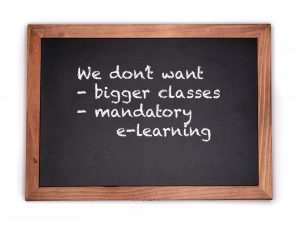Tory data on class size and e-learning – lost then found
Why did Doug Ford bother to spend taxpayers’ money consulting people across the province and refuse to acknowledge it?
 He says he doesn’t need to, as he told the legislature the other day “I’m out there, I talk to parents. I don’t go by some online poll…I talk to parents. I’m hearing overwhelmingly: number 1, they want these strikes to stop. They want their kids back in the class.” Then he went on to blame educators yet again for the bargaining logjam, saying “It’s all about compensation”
He says he doesn’t need to, as he told the legislature the other day “I’m out there, I talk to parents. I don’t go by some online poll…I talk to parents. I’m hearing overwhelmingly: number 1, they want these strikes to stop. They want their kids back in the class.” Then he went on to blame educators yet again for the bargaining logjam, saying “It’s all about compensation”
The Ford government strategy for talking to people is as old as propaganda. Say something often enough and people might believe you.
Class size consultations
The government consulted thousands of people across Ontario about class size and e-learning. It just didn’t release the results. It was able to sit on the information until last week when when Tom Doyle, chief negotiator for Ontario English Catholic Teachers Association, managed to get the data. He told an Ontario Labour Relations Board hearing that stakeholders from Black educators to board directors raised concerns about the impact on high school students of larger class sizes. According to information provided by Mr. Doyle, of the 7 000 surveys sent in by the public, 70 percent opposed larger class sizes. No one supported increasing sizes, even if they liked the idea of the government saving money.
School asked Ministry of Education officials for the data, but received no replies. Fortunately, the Ontario NDP was able to get the data and released the 132 page Class Size Consultation Summary today.
There were actually two consultations. One was with “stakeholders” – a sample of 62 people and organizations across the province during February 2019. On class size, the government reported in March 2019 that stakeholders across Ontario supported:
- Keeping class size maximums for grades 1-3 at 23 students with funding for primary classes at 19.8
- Make it more flexible to increase class sizes in grade 4-8 by allowing boards to maintain an average class size of 24.5 but letting them have larger classes, to enable them to have teacher librarians, gym teachers, smaller classes for high needs kids and so on.
- That it was important to provide flexibility over what it called “hard caps”or maximum limits to class size on school boards for high schools. It reported that “sector partners” put the ideal high school class size between 20 and 30 students. The government then went on to peg average class size at 28. Without that cap, high school classes could hit 40 or more.
As far as introducing 4 mandatory e-learning courses, the only support mentioned was a cryptic remark: “The ministry heard of the importance and requirement for flexibility and will continue to provide the flexibility that is important in meeting the needs of students and school communities”
But the data released by the ONDP today paints quite a different picture. As far as elementary schools, it turns out that these stakeholders were also concerned about:
- Cuts to front line staff
- Maintaining small primary grade classes
- Negative impact of larger class size to student learning
- Taking away hard caps to class sizes. Without them it’s harder to keep class sizes “consistent and equitable.”
- Increasing class sizes in rural areas for grades 4-8 would make it more difficult to staff them.
Regarding grades 9 -12:
- “student achievement will be negatively impacted by larger class sizes”
- classrooms won’t be able to accommodate the increases
- Graduation rates that have gone up since classes got smaller, will go down
- Schools won’t be able to offer the variety of courses students need – something which could negatively affect their post-secondary plans
- Larger classes will make it increasingly more difficult for teachers to provide individualized support
- financial savings through increasing class sizes can be achieved other ways
- there is insufficient evidence about the impact of larger class sizes on student achievement
- e-learning should be optional not mandatory
- mandating e-learning becomes an equity and logistics issue since not everyone has access to high-speed internet
- e-learning in general is not appropriate for all students
- expand e-learning as a test project, offering more course to interested students and use that information to guide future plans.
The Tories just weren’t telling the truth last year and certainly didn’t want the real story to get out.

There’s more. The rest of the Class Size Consultation Summary contains the information leaked to the press last week. This came from another survey by the Ford government beginning January 2019, the “Class Size Engagement” in which it invited people across the province to give their opinions on questions like these:
- Should the regulation continue to set hard caps on class sizes? Why or why not?
- If hard caps are to be set out in regulation, what is an appropriate class size limit?
- If hard caps were removed from regulation, what would be an appropriate mechanism to set effective class sizes?
- Are board-wide averages appropriate to set effective class sizes? Why or why not?
Before getting to the above questions, the survey skewed them by pointing out that “implementing hard caps on class sizes (as currently done in kindergarten and grades 1-3) is expensive and difficult for school boards to manage. It has been suggested that board- wide class size averages offer more flexibility for classroom organization and allows for more efficient use of board funds.”
Here are some highlights of the 7,036 submissions from the public last year – but finally seeing the light of day- today:
- 70 percent told the government “do not increase class sizes”
- 44 percent said doing so will have an impact on student learning and quality of education
- 42 percent said increased class sizes will result in less individual time for students
- 25 percent said the move would reduce supports for students wth special needs
- 21 percent said it would reduce supports for at risk students
Some of the recommendations noted about class size:
- “The class size cap should be 25 from grades 4-12”
- “Keep the average class size at 22”
- “The proposed change from 22 to 28 is much too drastic – it would be reasonable to change it from 22 to 24 but going upon to 28 is just too much”
- “High school classes need to be capped at 28 students not an average of 28; averages create class sizes that are just too large”
The public also weighed in on mandatory e-learning. There was no direct support for this move according to the Summary. Actually, 20 percent of submissions were opposed to mandatory e-learning. Other submissions cited problems with access to computers, concerns about student motivation and discipline, lack of both relationship building and accommodation for students with special needs.
Some of the recommendations regarding e-learning:
- “Centralizing the delivery of e-learning will NOT increase access. E-Learning should be delivered by local school boards”
- “If E-learning is mandated, it should stay administered by the school boards where teachers are already trained and equipped to do the work of teaching students electronically”
- “E-learning should be optional and not mandatory”
This was not a well-publicized consultation and the Ford government, as we know, released no information about the results. Back in September, Global News reported that parent groups including Ontario Families for Public Education, Scarborough Families for Public Education and West End Parents for Public Education were denied a Freedom of Information request for this information. The Ministry of Education had no explanation as to why information collected with taxpayers’ money about their school system needed hiding away.

In contrast, the Toronto District School Board (TDSB) actually wanted to find out what people thought of e-learning. So it asked 5 000 members of the TDSB community based on a random sample: Do you support the Ministry’s decision to require all students to take two e-learning/online learning credits in secondary school in order to graduate? Eighty-seven percent of the 428 students asked, replied “No”. Of the 1,938 parents surveyed, 81 percent said “No”; 97 percent of all secondary teachers gave the same answer.
To the question: “In your opinion, would e-learning/online learning benefit students?– responses were more equivocal: Sixty-seven per cent of the students in the sample said “No”, though 21 percent said they weren’t sure. Parents gave a similar opinion with 65 percent against the idea and 18 percent not sure. Secondary teachers were 91 percent opposed and 6 percent unsure.
Here is a survey with some credibility. The number of people surveyed is reported; results are broken down by group and there’s even some question permitted as to whether e-learning in general is worth consideration: Very few people across the board wanted e-learning to be mandatory; but some of them looked as though they might consider its benefits.
As TDSB Chair Robin Pilkey wrote to Education Minister, Stephen Lecce “I want to make it clear that the Board is not against e-learning. However, our survey found that there are significant concerns among students, parents and teachers related to your government’s plan for mandatory e-learning.”
It is possible to have a reasonable discussion about plans if you’re willing to be honest. But the Ford government prefers to win a battle with educators over class size and e-learning. It did it its best to make sure contrary information didn’t get out.
But that’s the problem with information kept under wraps. It has a habit of finding its way out.


